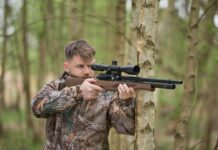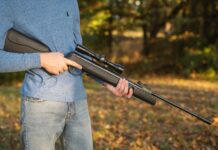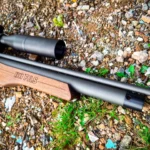To be very clear, moose is the largest species of deer, and no other species of deer can compete with moose size or height. After moose, elk is the second largest species of deer. If you aren’t a hunter or don’t live in those parts of the world where moose are found, you are surely unaware of the actual size of the moose or maybe just have seen it in pictures.
Further Reading
Latest Reviews of top Hunting Binoculars
Latest Reviews of the Best Binoculars for money
To make it easier for you and give you a clear picture, a fully grown moose look taller and bigger than even a horse. There are different subspecies of moose that are of varying size and weight. Most of the subspecies are taller as compared to other animals.
In this article, you can find out the average size of every subspecies of deer and compare their size with humans and animals, including deer, horses, and elephants.
Table of Contents
Moose Size Comparison – Subspecies of Moose
The name of the deer family in Latin is “Cervidae,” and the moose is the tallest and biggest species of the Cervidae family. Moose are brownish-black, almost black. Their appearance seems a little similar to a horse as both have long legs and the same body shape. However, moose have antlers while horses don’t.
Furthermore, moose have a droopy faceand dewlap covered with hairs. Their antlers are widespread, long, and have branches. So they add to the tall appearance of moose.
Moreover, there are a vast number of moose inhabited in Canada. The word moose evolved from the word “moosh,” which is from the language of the Innu people in Canada. There, “moosh” means bark eater. However, In European countries, moose are known as elk.
Moose has different subspecies, out of which four are the most prominent in Canada. These include (Alces alces America) Eastern moose from eastern Canada and the United States.
Alces andersoni, commonly known as northwestern moose, arepopulated in northern areas of Dakota, Michigan, central Canada, and Minnesota. Whereas the third subspecies is Shiras moose, inhabited in the Rocky Mountains of the United States.
Based on their distinctive traits and geographical location, some further moose species are Siberian Moose, Yakut Moose, and European moose, collectively recognized as Eurasian moose. The geographical areas affect the inhabited moose there and cause variation in their characteristics, leading to the evolution of subspecies.
Size of Different types of Moose – Comparison
All the subspecies of moose vary in their average weight, height, size of antlers, and skin color. The gigantic subspecies are Alaskan Yukon moose, mostly found near rivers in Alaska.
Alaska Moose
Male Alaskan moose can weigh more than 1800 pounds, while females have an average weight of 1000 to 1100 pounds with more than 7 feet in height. They can grow antlers of over 1.8 m in length.
Western Moose
After Alaskan moose, the second-largest subspecies is western moose from the western regions of Canada and the United States. The weight of male western moose is about 1000 to 1500 pounds, female between 600 to 800 pounds, and height is between 6 to 7 feet only up to the shoulders. Their antlers are a little smaller than the antlers of Alaskan moose, about 1.6 or 1.7 meters.
Eastern Moose
Eastern moose, which weigh around 1400 pounds, is the third-largest subspecies of moose. A male eastern moose has a height of 5.5 to 6.5 feet and weighs 1300 to 1400 pounds, while the female eastern moose can weigh around 600 to 700 pounds with 5.6 feet height.
Siberian Moose
Aside from these species, the largest subspecies of the Eurasian species is the East Siberian moose. Siberian moose are smaller in height and weight as compared to Alaskan moose.
Yellowstone Moose
Even the smallest subspecies of moose weigh up to 1000 pounds and are at least 5 to 6 feet tall. These species are named Yellowstone moose, inhabited in North America, Russia, and China.
Moose Size Comparison with Others
Moose vs. Deer
The adult male moose are called bulls, while the adult female moose are cows. Both are heavier and bigger than all other species of deer. The whitetail deer, blacktail deer, or elk cannot compete with moose size and weight.

Such as, the whitetail deer only weighs between 100 to 300 pounds with 3 feet shoulder length that is much smaller than a moose, almost half or even less than that. Similarly, an elk is also foot smaller than a moose.
Moose Size Compared To Horse
When comparing the height of a horse and moose, we consider that the height of horses is measured from their hoofs to the withers that are the part between the upper back shoulders. The average height of a horse is almost five and a half inches.

However, just like the moose, horses also vary in their height. There is also the smallest and tallest size for a horse. Comparing the tallest horse and moose, they can be almost the same height, i.e., 7 feet. But due to their bulkiness, a moose will still appear bigger than a horse.
Moose Elephant Size Comparison
No doubt that a deer, elk, or horse are smaller than moose, but comparing moose with other animals, such as elephants, one of the heaviest animals living on the earth, can make a seven-foot-tall moose seem smaller.

Like moose, different species of elephants and male and female elephants vary in average weight. An elephant can be an 11 to 13 feet tall male or only an 8 feet tall female elephant. So a female elephant and a male moose may stand at almost the height.
Moose Compared to Human
Have you ever seen a moose from close? No wonder that 7 feet or even more than that tall and heavy moose with wide antlers will make you look tiny in front of it. The moose are measured by their shoulders; their antlers make them even taller.

Even the height recorded of the tallest man alive on earth cannot exceed the height of a fully grown Alaskan moose.
Wrapping Up – Moose Size Comparison
Moose are the largest and most gigantic species of deer. Comparing moose with animals such as horse and elk give us the result that they are larger than all those animals. Similarly, humans are also tiny in front of a moose. But a moose can not exceed the height of an elephant; that is itself a large and bulky animal.
Additional Common Questions
How do moose measure up to other animals in terms of size?
In terms of size, a full-grown Alaskan moose is truly a majestic sight, often standing taller than 7 feet. To truly grasp the size of these magnificent creatures, think about those towering NBA giants, like Yao Ming, who stands at a staggering 7 feet 6 inches – a moose is essentially the Yao Ming of the animal kingdom! To further contextualize, horses, which we often perceive as large animals, measure an average of about 5 feet 4 inches at the withers, or shoulder height. This height places an average male Alaskan moose around a foot to a foot and a half taller at the shoulders than a horse. So an up-close encounter with a moose might feel a lot like standing next to an absolutely massive horse, dwarfing those familiar four-legged companions!
Do we have any animal that can size up to a moose?
Interestingly, there are animals that match up to the size of a moose, or even surpass it. One great example is the bison. Bison tend to outsize moose in most physical terms. On the scale, moose can weigh in at an impressive 1,500lbs, while bison can tip the scale up to a massive 3,000lbs or even more. When it comes to height, the moose can carry its head high up to 6.9ft at the shoulder and grow to an impressive total length of 10ft. However, bison have a naturally raised hump, which helps them achieve a total height of 11ft. Despite their towering height, bison generally maintain a body length somewhat shorter than a moose, about 9 feet. So imagine yourself on a safari tour sitting in a truck and being approached by a herd of bison. Their hump would be above your field of view, making them look like a moving wall – an experience highlighting their towering stature and sheer mass!
What is the size of a moose when it is fully grown?
As full-grown adults, male moose (also known as bulls) reach awe-inspiring dimensions, while females (cows) are somewhat smaller. The average adult bull moose stands around 6 feet tall at the shoulder. Recalling our human equivalent, that’s like standing up to the chest of a person who is 6 feet tall! As for their weight, well-fed and healthy male moose can weigh up to a massive 1,400 pounds, that’s the equivalent of carrying around seven adult humans! However, unlike in males, female moose, although also large, don’t reach these extremes. Their lower size requirements make sense from an evolutionary perspective as smaller size allows them a higher rate of survival.
How does the size of a moose compare to a car?
When we compare a moose to a car, we can gauge their size in a familiar context. A moose can tip the scales upwards to 1,500 pounds, reach a height of almost 7 feet, and extend up to 10 feet from nose to tail. In contrast, your average family car, weighing around 3,500lbs, far outweighs a moose. The car’s height, standing at around 4.75ft, is shorter compared to the towering moose. However, in terms of length, a car stretches further up to around 16.3 feet. If you’ve ever seen those road signs warning against moose in certain regions, now you know why. A collision with these massive animals can cause substantial damage due to their considerable weight and height. Just think about how your car would fare in an unfortunate meeting with this gigantic animal that’s comparable in weight to a small car and can look straight into your car window!










































![Air gun 101: The differences between .177 & .22 – Which jobs they do best ? [Infographic]](https://airgunmaniac.b-cdn.net/wp-content/uploads/2024/11/1773-150x150.jpeg)
